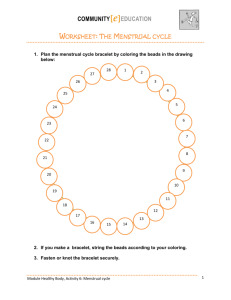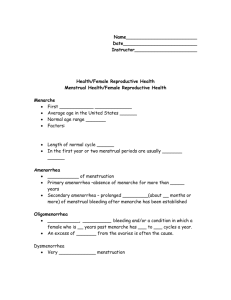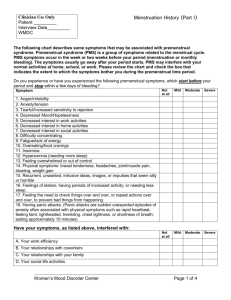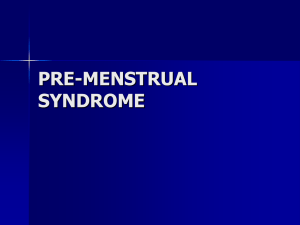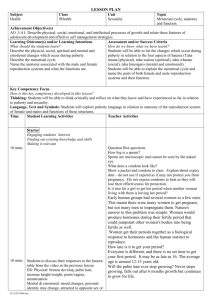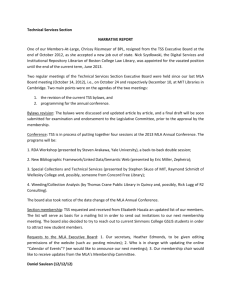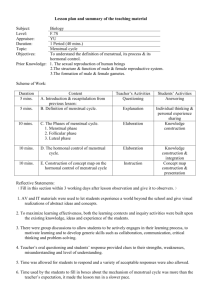The Menstrual Cycle
advertisement
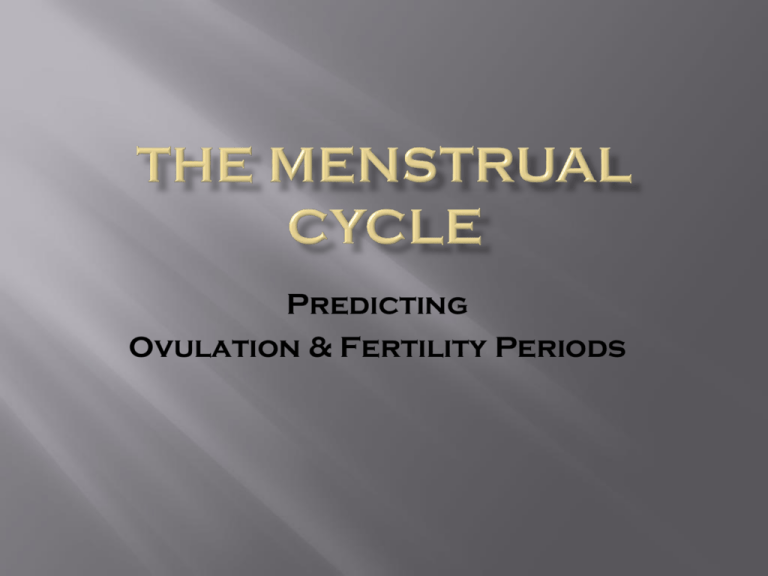
Predicting Ovulation & Fertility Periods Menstruation is considered a unique indicator of a woman’s overall _____________. Answer: Physical Health • • The menstrual cycle is viewed as a reliable predictor of a woman’s general health and well-being. The lack of or complete loss of a woman’s cycle could indicate issues with fertility, bone health, heart disease, and ovarian failure. Menses 1. The periodic flow of blood and mucosal tissue from the uterus. 2. The monthly flow of blood and cellular debris from the uterus that begins at puberty and ceases at menopause. This process is also referred to as emmenia, a menstrual cycle or period. If an ovum is not fertilized, or if the fertilized ovum does not attach to the uterine wall, the uterine lining is not needed The muscles of the uterus contract, causing the lining to gradually break down The lining passes through the cervix into the vagina and out through the vaginal opening 4 to 7 days Cycles Vary from female to female Natural causes 1. Pregnancy 2. Breast-feeding 3. Menopause Lifestyle factors 1. Stress - Mental stress can temporarily alter the functioning of your hypothalamus — an area of your brain that controls the hormones that regulate your menstrual cycle. Ovulation and menstruation may stop as a result. Regular menstrual periods usually resume after your stress decreases. 2. Low body weight - Excessively low body weight interrupts many hormonal functions in your body, potentially halting ovulation. Women who have an eating disorder, such as anorexia or bulimia, often stop having periods because of these abnormal hormonal changes. Lifestyle factors 3. Excessive exercise - Women who participate in sports that require rigorous training, such as dance, body building, long-distance running, cycling, and gymnastics may find their menstrual cycle interrupted. Several factors combine to contribute to the loss of periods in athletes, including low body fat, stress and high energy expenditure. Medications – Antipsychotics, Cancer chemotherapy, Antidepressants, and Blood pressure drugs Contraceptives - Some women who take hormonal birth control may not have periods. Contraceptives that are ingested, injected, absorbed, or implanted (intrauterine & sub-dermal), may cause amenorrhea. When hormonal contraceptives are stopped, it may take three to six months to resume regular ovulation and menstruation cycles. What is PMS? Psychotic Mood Shift Puffy Mid-Section Pardon My Sobbing Pissy Mood Syndrome Premenstrual Syndrome Most women have tender breasts, bloating, and muscle aches a few days before they start their menstrual cycle. These are normal premenstrual symptoms. But when they affect your daily life, they are called premenstrual syndrome (PMS). PMS can affect your body as well as your mood. Sometimes it can make you change the way you act. PMS is tied to hormone changes that happen during your menstrual cycle. Doctors don't fully know why premenstrual symptoms are worse in some women than in others. They do know that for many women, PMS runs in the family. PMS symptoms can affect your body, your mood, and how you act in the days or week leading up to your menstrual period. Physical signs include: Acne Bloating and tender breasts Food cravings Lack of energy Cramps Headaches Low back pain When you have PMS, you might also: Feel sad, angry, or anxious Be less alert Find it hard to focus on tasks Want to withdraw from family and friends Act in a forceful or hostile way (CRAZY) We have humor and the pleasure of never personally experiencing PMS. http://www.softcup.com/ What is TSS? Toxic Shock Syndrome (TSS) is a rare, but potentially serious disease that has been associated with tampon use. In rare cases, TSS can be fatal. TSS is believed to be caused by toxin-producing strains of the staphylococcus aureus bacterium. What causes TSS? The bacterium that causes TSS is found most commonly on the skin, in the nose, armpit, groin or vagina. In fact, about one third of the population carry it without any problem at all. However, in a very small number of people, certain strains of the bacterium produce toxins that can cause TSS. Most people have the antibodies in their bloodstream to protect them from the toxin if it is produced, but many do not. What is the link between TSS and tampon use? The link is not clearly understood. However, tampon research shows that the risk of tampon-related TSS is associated with absorbency: the higher the absorbency the higher the risk; the lower the absorbency, the lower the risk. That is why a woman should always use the lowest absorbency tampon for her menstrual flow. What are the symptoms of TSS? Some of the symptoms are much the same as the flu, but they can become serious very quickly. The warning signs of TSS are: Sudden high temperature (102 degrees F/38.9 degrees C or higher) Vomiting Diarrhea A sunburn-like rash Muscle aches Dizziness Fainting or feeling faint when standing up If you have any of these symptoms and are wearing a tampon you should remove the tampon immediately and contact your doctor for immediate treatment. Tell the doctor that you have been using tampons and suspect that you may have TSS. Don’t worry about being an alarmist. What's important is to get speedy treatment. Calendar or Rhythm Method Basal Body Temperature Method Ovulation/Cervical Methods Rise in body temperature after ovulation Sampling of cervical mucus and cervical positioning Ovulation Predictor Kits Combination of all methods or urine sample tests Three Cycles Initial Spotting Period Ends Possible Ovulation End of Cycle Use the calendar method to develop a three month timeline that depicts the following woman’s menstrual cycle. Length of cycle: 28 days Duration of Period: 5 days Initial spotting : May 15th “Fertile Time” Possible Ovulation range: ??? Most women ovulate anywhere between Day 11 and Day 21of their cycle, counting from the first day of the last menstrual period (LMP). For this lesson we will use the cycle midpoint, plus three days before and after as our “Fertile Time.” Initial Spotting July 10 May 19 June 16 July 14 Possible Ovulation June 12 Period End May 15 May 25-31 June 22-28 July 20-26 July 9 Aug. 6 End of Cycle June 11

